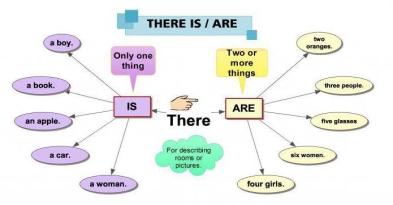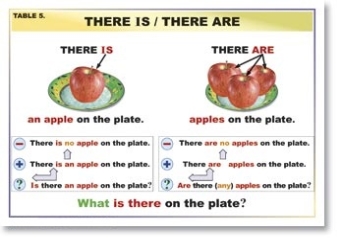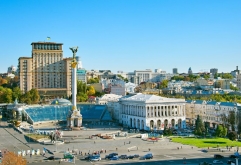Поїздка до столиці. Структура: there is/there are.
План-конспект уроку
Клас: 5
Тема уроку: Подорож
Підтема уроку: Поїздка до столиці. Структура: there is/there are.
Практичні задачі: активізувати словниковий запас учнів; відпрацьовувати в учнів навички говоріння, аудіювання, читання та письма; розвивати творче мислення.
Освітні задачі: придбання навиків самостійної роботи, прищеплення учням бажання вивчати англійську мову, перевірити навички і уміння монологічної та діалогічної мови, а також аудіювання.
Розвиваючі задачі: розвивати інтерес до предмету, увагу, логічне мислення, вміння вести бесіду; розвивати бажання для отримання більш детальної інформації по темі, що вивчається.
Виховні задачі: виховувати поважне відношення до мови і культури іншої країни; виховувати культуру спілкування і потреби у практичному користуванні мови.
Тип уроку: формування знань, умінь і навичок.
Обладнання: підручник, презентація, картки.
Хід уроку
І. ПІДГОТОВКА ДО СПРИЙНЯТТЯ ІНШОМОВНОГО МОВЛЕННЯ
1. Організаційний момент.
- Stand up! Stand straight!
- Good morning children. I am glad to see you.
- Who is on duty today? Who is absent?
2. Розминка (warming up).
T: Now children let’s begin our lesson. Everyone open your exercise books and write down the day and the date. Now children answer my questions:
-What is your name?
-Where do you live?
-Who are you?
-When do you usually get up?
-What form are you in?
-Do you go to school in the morning or in the afternoon?
-What do you usually do in the morning?
-When do your lessons begin?
-What do you do at school?
-What do you usually do after classes?
-What do you usually do in the evening?
-When do you usually go to bed?
3. Повідомлення теми та мети уроку.
Т: Today we are going to speak about the usage there is/there are. We shall revise the material of our previous lessons and speak about Kyiv.
ІІ. ОСНОВНА ЧАСТИНА УРОКУ
1. Перевірка домашнього завдання.
Т: And now let's test your homework.
 2. Ознайомлення з новим граматичним матеріалом.
2. Ознайомлення з новим граматичним матеріалом.
Т: Now let's study the rule.
Схема 1.
Конструкція «THERE IS(ARE)» широко вживається в англійській мові для повідомлення про наявність у даному місці будь-якої особи або предмета. Дана конструкція вживається як в однині так і у множині. Це ми бачимо на малюнку. Слово «there» є тут «фіктивним» підметом. Його не потрібно перекладати на українську мову. Чому саме воно прижилося на цьому місці-не так важливо, тому його потрібно вивчити і звикнути.
Конструкція «There is» вживається, якщо за ним йде іменник у однині (злічуваний іменник вживається з невизначеним артиклем).
Конструкція «There are» вживається, якщо за ним йде іменник у множині (іменник у множині вживається без артикля).
Перекладається конструкція з кінця.
 Основна схема речення:
Основна схема речення:
Схема 2.
Речення з конструкцією There is/are.
4. Закріплення граматичного матеріалу уроку.
Т: So children’s change our activity. Go to the blackboard one by one and translate the following sentences from Ukrainian into English.
1. У портфелі знаходиться ручка.
2. У класі є учні.
3. На вулиці немає дітей.
4. На дереві знаходиться птах.
5. У коробці немає іграшок.
6. Під деревом є гриби ? Немає.
7. У кімнаті немає килима.
8. У чашці є молоко? Так.
9. На небі сірі хмари.
10. На столі є олівці? Ні.
T: Very good!
5. Активізація лексичних одиниць.
Match the parts of word combinations.
1) Chimeras a) Cathedral
2) Andriyivskiy b) Gate
3) Olympic c) Uzviz
4) Kyiv-Pecherska d) House
5) Golden e) Stadium
6) St. Sophia’s f) Lavra
6. Читання тематичного тексту.
T. And now we’ll have an imaginary trip around Kyiv.
 a) Pre–reading activity. There are some new words which are difficult for pronunciation:
a) Pre–reading activity. There are some new words which are difficult for pronunciation:
Admire - милуватися
souvenir - сувенір
mosaic - мозаїка
frescoes - фрески
ancient - давній
b) Game «Stop reading! »
T: We’ll play «Stop reading! ». I’ll read you the text with some mistakes. Your task is to correct me and read the information without mistakes.
Text «A Trip around Kyiv»
Kyiv, the city (capital) of Ukraine, is on the Dnipro River. The city is less than (more than) one thousand five hundred years old. The shortest (main) street of the capital is Khreshchatyk Street. Independence Square is at the eastern (northern) end of Khreshchatyk Street. It is the most popular square (place) for national celebrations and holiday events.
The national (historical) heart of the city is Podil. All the children (visitors) who come here admire St. Andrew’s Church. Andriyivskiy Uzviz (Descent) is very popular with Kyivites (tourists). It is the best place to buy Ukrainian food (souvenirs) and art and crafts.
St. Sophia’s Cathedral is famous for its beautiful paintings (mosaics) and frescoes.
The Golden Gate is another building (monument) from the 11th century. It was built during the time of Volodymyr (Yaroslav) the Wise and it served as the main gate (entrance) to the city.
Kyiv is a city where old (ancient) and modern live side by side. There are so much (many) places to visit that we can’t see everything during one short travelling (trip).
c) Reading of the text.
T: Well done! You should read the text and then we will do some tasks.
d) Comprehension task.
T: Listen to my questions and give short answers.
1. Where is Kyiv situated?
2. What is the main street of Kyiv?
3. What is the most popular place for national celebrations?
4. What is the best place to buy Ukrainian souvenirs and art and crafts?
5. What is St. Sophia’s Cathedral famous for?
6. Who built the Golden Gate?
e) True or False.
T: That's great! Read the statements and write if they are true or false.
1) Kyiv is situated on the banks of the Dniester River. (F)
2) Khreshchatyk is the main street of Kyiv. (T)
3) Independence Square is at the southern end of Khreshchatyk. (F)
4) Andriyivskiy Uzviz is the historical heart of the city. (F)
5) Andriyivskiy Uzviz is very popular among tourists. (T)
6) The Golden Gate served as the main entrance to the city in ancient times. (T)
ІІІ. ЗАКЛЮЧНА ЧАСТИНА УРОКУ
1. Домашнє завдання.
Впр.10 c, стор.121 (письмово), повторити лексику теми.
2. Підведення підсумків уроку. Рефлексія.
T: Today you've learned about sport in Kyiv. Don't you think the getting knowledge can help you in your real life?
T: And now your marks ….
T: Thank you, everybody. Good-bye!


про публікацію авторської розробки
Додати розробку
